The Avitourist’s Guide to Hawaii
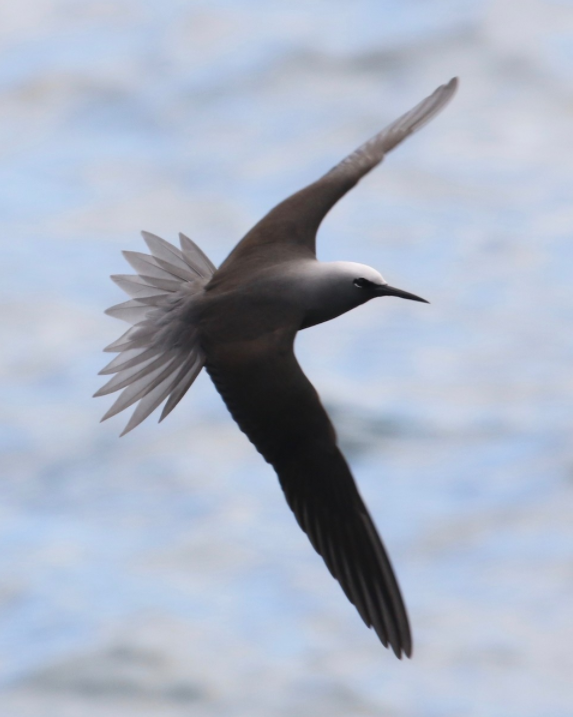
The endemic “Hawaiian Noddy” (Anous minutus melanogenys) is currently classified as a subspecies of Black Noddy, but it is a likely candidate for eventual recognition as a separate species. © Laurens Halsey
This Hawaiian birdfinding guide combines two topics: (1) Hawaii’s birds and (2) where to find them. For the birds, see Birds of Hawaii. For information about where to go when visiting the islands, start with these pages: Kauai, Oahu, Maui, the Big Island, or this index.
Each of the main islands supports some unique endemic species of its own: Oahu has two; Maui has three; Kauai has six; and the Big Island has eight. Each island has lost several endemics to extinction since Europeans first arrived in 1778, and a few of the endemics that remain are near the brink—in particular, the Hawaiian Crow is currently confined to captive-breeding facilities on the Big Island and Maui (it is not currently a free-flying wild species), and on Kauai the Akikiki seems to be vanishing rapidly. Beyond the main islands, the string of widely separated atolls known as the Northwest Chain adds four more endemics—Laysan Duck, Millerbird, Laysan Finch, and Nihoa Finch—whose entire ranges are off-limits to the general public.
Endemic Birds of Hawaii
Hawaiian Goose / Hawaiian Duck / Laysan Duck / “Hawaiian Gallinule” / Hawaiian Coot / “Hawaiian Storm-Petrel” / Hawaiian Petrel / Newell’s Shearwater / “Hawaiian Stilt” / “Hawaiian Noddy” / Hawaiian Hawk / “Hawaiian Short-eared Owl” / Kauai Elepaio / Oahu Elepaio / Hawaii Elepaio / Hawaiian Crow / Oma’o / Puaiohi / Millerbird / Akikiki / Maui Alauahio / Palila / Laysan Finch / Nihoa Finch / Akohekohe / Apapane / I’iwi / Maui Parrotbill / Akiapola’au / Anianiau / Kauai Amakihi / Oahu Amakihi / Common Amakihi / Hawaii Creeper / Akeke’e / Hawaii Akepa
For a prospective visitor with limited time considering which island(s) to visit, the bottom of this page provides a list of Hawaiian “specialty” birds (species that are either impossible or difficult to find on the mainland of North America) with an approximate rating of their abundance on each of the main islands. In terms of species diversity, the islands rank as follows:
The Big Island has the most surviving single-island endemics—eight: Hawaiian Hawk, Hawaii Elepaio, Hawaiian Crow, Oma’o, Palila, Akiapola’au, Hawaii Creeper, and Hawaii Akepa—plus all but one of the Hawaiian endemics that occur on multiple islands (lacking only the “Hawaiian Gallinule” of Kauai and Oahu). Except for the crow, all of its endemics can be found with some planning and reasonable luck. The Big Island offers excellent opportunities to see many seabirds from shore and convenient access to offshore waters. Finally, it has a large complement of introduced species, including three that are not established anywhere else in North America.
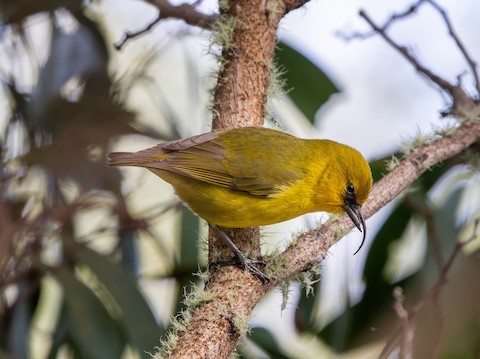
Certainly Hawaii’s most bizarre bird, the Akiapola’au, is rare and endemic to the Big Island, but three closely related species (the now-extinct nukupu’us) inhabited the other main islands into the early years of European settlement. © William Higgins
Kauai has the second-most surviving single-island endemics—six: Kauai Elepaio, Puaiohi, Akikiki, Anianiau, Akeke’e, and Kauai Amakihi—plus all but one of the Hawaiian endemics that occur on multiple islands (lacking only the Common Amakihi of the Big Island, Maui, and Molokai). Three of its endemics (Puaiohi, Akikiki, and Akeke’e) are effectively confined to the Alakai Plateau, where they are very difficult to find, and two of these are trending toward extinction in the foreseeable future—so it might already be too late to find them, but if not, then time is of the essence. Kauai offers outstanding opportunities to see many seabirds from shore and fairly convenient access to offshore waters. Its introduced species include two that are not established anywhere else in North America.
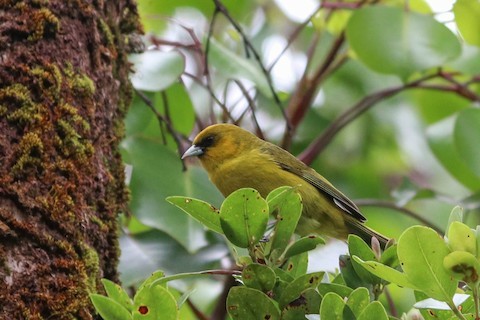
The Akeke’e has declined rapidly since the 1990s—by 2020 it had mostly retreated to the Alakai Plateau. © Jen Sanford
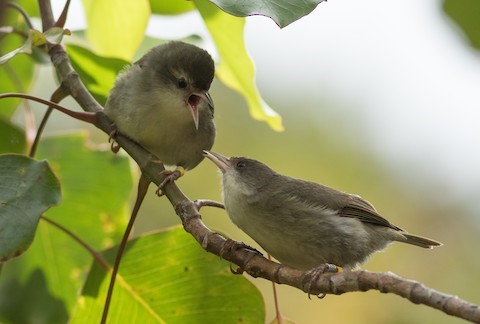
The mouselike Akikiki may have already vanished from all publicly accessible areas. © Joachim Bertrands
Oahu’s two surviving single-island endemics—Oahu Elepaio and Oahu Amakihi—are both findable, but it has the lowest number of Hawaiian endemics that occur on multiple islands. Oahu offers outstanding opportunities to see many seabirds from shore—including the world’s only urban population of Common Fairy-Tern—and convenient access to offshore waters. It has a large complement of introduced species, including two that are not established anywhere else in North America. One of these, the Mariana Swiftlet, is found only on Oahu and the remote Mariana Islands of western Micronesia.
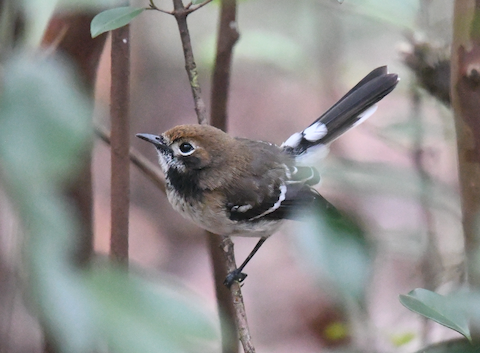
The endangered Oahu Elepaio is uncommon and declining, but it can still be found in the hills above Honolulu. © Charlie Bostwick
Maui has three surviving single-island endemics—Maui Alauahio, Akohekohe, and Maui Parrotbill—as well as most of the Hawaiian endemics that occur on multiple islands. Two of its endemics (Akohekohe and Maui Parrotbill) are very challenging to find, one (the parrotbill) may be trending toward extinction, and both are effectively confined to private property that requires special arrangements to visit: the Waikamoi Preserve. Maui offers comparatively few opportunities to see seabirds from shore and limited prospects for offshore trips. It has a large complement of introduced species, but none that cannot be found elsewhere in North America.
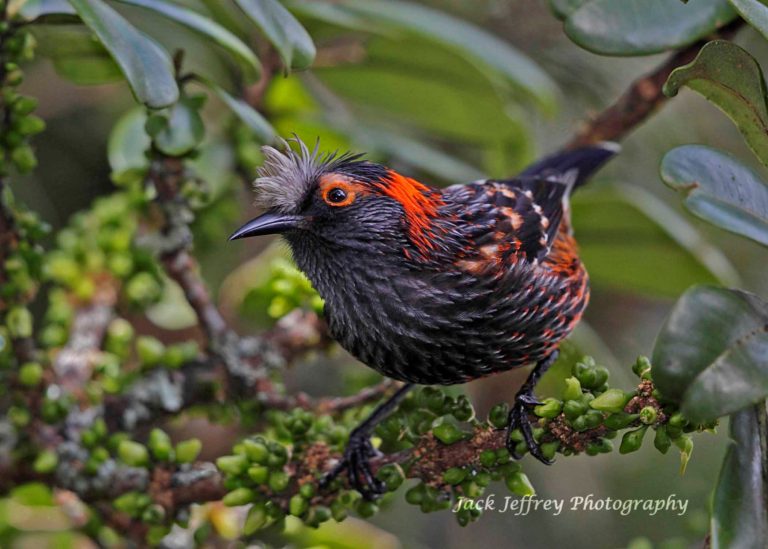
The exquisite, endangered Akohekohe has become very difficult to find in its remnant range on Maui. © Jack Jeffrey
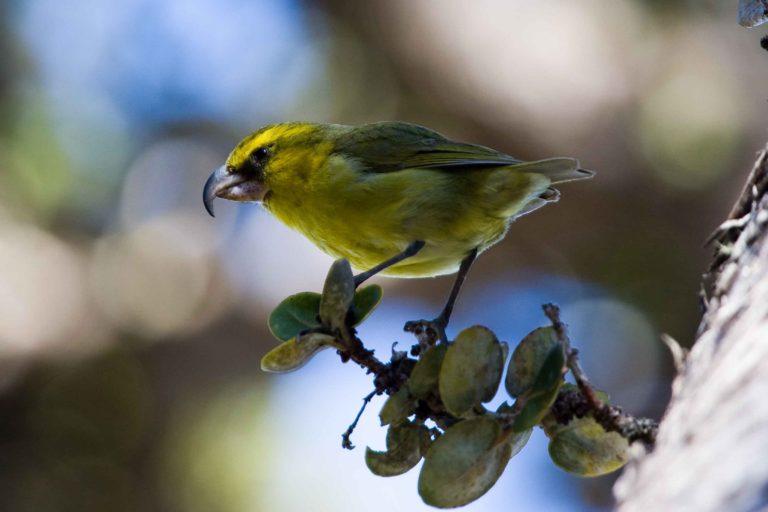
The peculiar and critically endangered Maui Parrotbill inhabits the same small area and is even harder to find. © Robby Kohley
The remaining islands that are open to visitors, Molokai and Lanai, no longer support any single-island endemics. Each lost its last unique species to extinction in the 1900s. There is a very slim, effectively negligible possibility that the Oloma’o still survives in an inaccessible part of Molokai—but this is academic and irrelevant to travel-planning. Either island might offer a few birds of interest, but these prospects do not compare to the four larger islands.
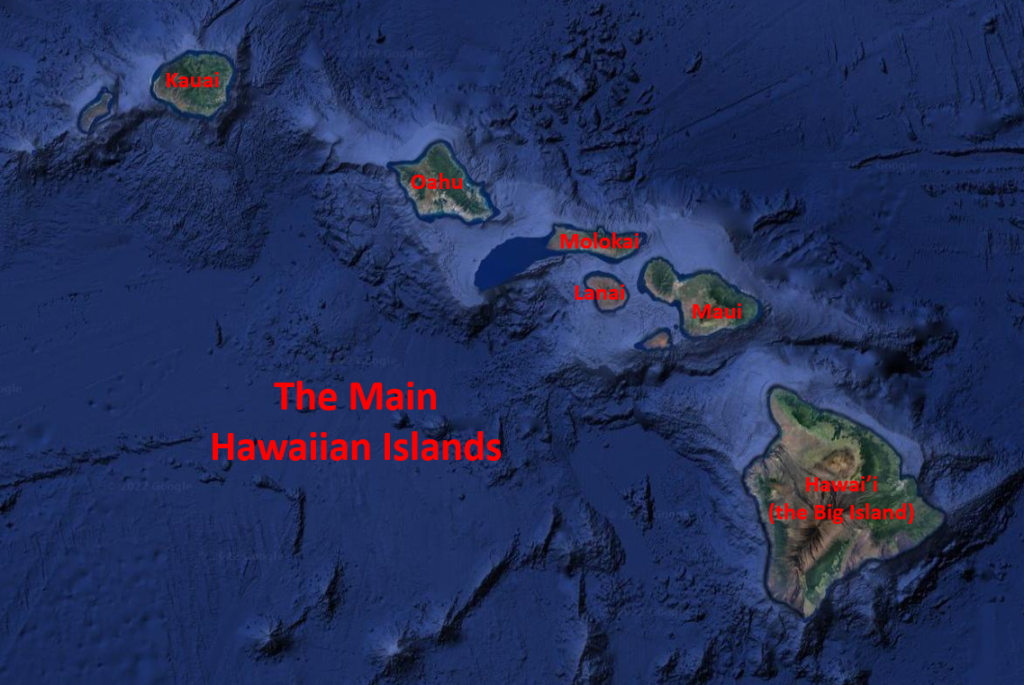
Hawaiian Specialties: Which Birds Are on Which Islands
The 120 species listed below include: (1) all surviving (as of 2022) Hawaiian endemics; (2) all pelagic seabirds (i.e., those that tend to remain far offshore when not breeding) that are thought to occur regularly around the main Hawaiian Islands; (3) most of the introduced landbirds that have apparently viable populations in the main Hawaiian Islands; (4) and a few migrant waterbirds that are rare or localized in North America but occur regularly on the main Hawaiian Islands. The abundance codes mean approximately the following:
C = Common: can be expected during most of the year in areas that do not require special access, without much planning or luck.
U = Uncommon: local, access-restricted, or seasonal, but reasonably likely to be found under conditions that are feasible to plan.
R = Rare: presumed to be present, at least sporadically, but not likely to be found except by chance.
| Species | Kauai | Oahu | Maui | Big Island | Notes |
|---|---|---|---|---|---|
| Hawaiian Goose | C | R | C | C | Endemic |
| Laysan Duck | NW Chain Only | ||||
| Hawaiian Duck | C | R | U | Endemic | |
| California Quail | C | C | Introduced | ||
| Gambel’s Quail | R | Introduced | |||
| Wild Turkey | R | C | C | Introduced | |
| Chukar | C | U | Introduced | ||
| Black Francolin | C | U | C | C | Introduced |
| Gray Francolin | U | C | C | C | Introduced |
| Erckel’s Francolin | C | U | C | Introduced | |
| Japanese Quail | R | R | Introduced | ||
| Red Junglefowl | C | Introduced | |||
| Kalij Pheasant | U | C | Introduced | ||
| Indian Peafowl | R | U | C | U | Introduced |
| Chestnut-bellied Sandgrouse | C | Introduced | |||
| Eastern Spotted Dove | C | C | C | C | Introduced |
| Zebra Dove | C | C | C | C | Introduced |
| “Hawaiian Gallinule” | C | C | Endemic | ||
| Hawaiian Coot | C | C | C | C | Endemic |
| Yellow-billed Tropicbird | C | C | C | C | |
| Red-billed Tropicbird | R | ||||
| Red-tailed Tropicbird | C | C | U | U | |
| Laysan Albatross | C | C | U | U | |
| Black-footed Albatross | U | U | R | R | |
| “Hawaiian Storm-Petrel” | U | R | R | U | Endemic |
| Tristram’s Storm-Petrel | R | ||||
| Leach’s Storm-Petrel | U | U | U | U | |
| Bonin Petrel | R | ||||
| Black-winged Petrel | U | U | R | U | |
| Cook’s Petrel | R | R | R | U | |
| Stejneger’s Petrel | R | R | R | R | |
| Mottled Petrel | U | U | R | U | |
| Kermadec Petrel | R | ||||
| White-necked Petrel | R | R | R | R | |
| Juan Fernández Petrel | R | R | R | U | |
| Hawaiian Petrel | U | R | C | U | Endemic |
| Bulwer’s Petrel | U | U | U | U | |
| Wedge-tailed Shearwater | C | C | C | C | |
| Buller’s Shearwater | R | R | R | U | |
| Sooty Shearwater | U | U | U | U | |
| Short-tailed Shearwater | R | R | R | R | |
| Christmas Shearwater | U | U | R | U | |
| Newell’s Shearwater | U | R | R | U | Endemic |
| Great Frigatebird | C | C | C | U | |
| Red-footed Booby | C | C | C | U | |
| “Forster’s Booby” | C | C | C | C | |
| “Brewster’s Booby” | R | ||||
| Masked Booby | U | C | R | U | |
| Pacific Golden-Plover | C | C | C | C | |
| “Hawaiian Stilt” | C | C | C | C | Endemic |
| Bristle-thighed Curlew | R | C | R | U | |
| Sharp-tailed Sandpiper | R | R | R | R | |
| Wandering Tattler | C | C | C | C | |
| Long-tailed Jaeger | R | R | R | R | |
| Parasitic Jaeger | R | R | R | R | |
| Pomarine Jaeger | R | R | R | R | |
| South Polar Skua | R | R | U | ||
| Common Fairy-Tern | R | C | R | U | |
| Sooty Tern | U | C | U | U | |
| Gray-backed Tern | R | U | |||
| Brown Noddy | C | C | U | U | |
| “Hawaiian Noddy” | C | C | C | C | Endemic |
| “Pacific Black Noddy” | R | ||||
| Blue Noddy | R | ||||
| American Barn Owl | C | C | C | C | Introduced |
| “Hawaiian Short-eared Owl” | C | R | C | C | Endemic |
| Mariana Swiftlet | U | Introduced | |||
| Hawaiian Hawk | C | Endemic | |||
| Rose-ringed Parakeet | C | C | Introduced | ||
| Rosy-faced Lovebird | C | C | Introduced | ||
| Red-crowned Parrot | C | Introduced | |||
| Red-masked Parakeet | C | C | Introduced | ||
| Kauai Elepaio | C | Endemic | |||
| Oahu Elepaio | U | Endemic | |||
| Hawaii Elepaio | C | Endemic | |||
| Hawaiian Crow | In Captivity Only | ||||
| Common Myna | C | C | C | C | Introduced |
| Oma’o | C | Endemic | |||
| Puaiohi | R | Endemic | |||
| White-rumped Shama | C | C | U | Introduced | |
| Eurasian Skylark | R | U | C | C | Introduced |
| Millerbird | NW Chain Only | ||||
| Red-whiskered Bulbul | C | Introduced | |||
| Red-vented Bulbul | C | Introduced | |||
| Japanese Bush-Warbler | C | U | C | C | Introduced |
| Warbling White-eye | C | C | C | C | Introduced |
| Red-billed Leiothrix | C | C | C | Introduced | |
| Chinese Hwamei | C | U | C | C | Introduced |
| Greater Necklaced Laughingthrush | U | Introduced | |||
| Lavender Waxbill | U | Introduced | |||
| Orange-cheeked Waxbill | U | Introduced | |||
| Common Waxbill | C | C | C | C | Introduced |
| Red Avadavat | C | C | C | Introduced | |
| African Silverbill | C | C | C | C | Introduced |
| Scaly-breasted Munia | C | C | C | C | Introduced |
| Chestnut Munia | C | C | C | U | Introduced |
| Java Sparrow | C | C | C | C | Introduced |
| Akikiki | R | Endemic | |||
| Maui Alauahio | C | Endemic | |||
| Palila | U | Endemic | |||
| Laysan Finch | NW Chain Only | ||||
| Nihoa Finch | NW Chain Only | ||||
| Akohekohe | R | Endemic | |||
| Apapane | C | U | C | C | Endemic |
| I’iwi | U | C | C | Endemic | |
| Maui Parrotbill | R | Endemic | |||
| Akiapola’au | U | Endemic | |||
| Anianiau | U | Endemic | |||
| Kauai Amakihi | C | Endemic | |||
| Oahu Amakihi | C | Endemic | |||
| Common Amakihi | C | C | Endemic | ||
| Hawaii Creeper | U | Endemic | |||
| Akeke’e | R | Endemic | |||
| Hawaii Akepa | U | Endemic | |||
| Yellow-fronted Canary | C | C | Introduced | ||
| Western Meadowlark | C | Introduced | |||
| Red-crested Cardinal | C | C | C | Introduced | |
| Yellow-billed Cardinal | C | Introduced | |||
| Saffron Finch | U | C | R | C | Introduced |
| Yellow-faced Grassquit | U | Introduced |